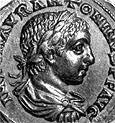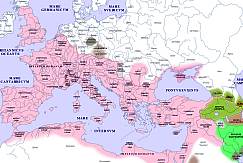
 Virtual
Catalog of Roman Coins
Virtual
Catalog of Roman Coins

An Online Encyclopedia of Roman Emperors Elagabalus (218-222 A.D.)
Michael L. Meckler
Ohio State University

Marcus Aurelius Antoninus, the "last of the Antonines," is better known to history as Elagabalus, the name of the sun-god of the Syrian city of Emesa. Elagabalus the emperor was a high-priest of this deity, and his active promotion of the god was among several actions that made him an object of scorn and ridicule among the Roman aristocracy.The emperor was born with the names Varius Avitus Bassianus sometime between the autumn of 203 and the spring of 204. His mother, Julia Soaemias, was a niece of the emperor Septimius Severus' wife Julia Domna. As a child this future emperor seems to have been raised in the company of his great-aunt the empress, spending his earliest years in Rome and traveling (around the age of 5) with the imperial court to Britain during Severus' campaigns on the island. Elagabalus' family became even more prominent after Severus' death and Geta's murder, with the boy's father and maternal grandfather each holding important offices during the reign of Caracalla.
Both the father and the grandfather were dead by the spring of 217, when Caracalla was murdered in Syria between campaigns against the Parthians, and Macrinus became emperor. Contemporary historians first mention Elagabalus at this time. He was living in Emesa with his mother in the household of his grandmother, Julia Maesa, and he was beginning to perform in the hereditary family role of high-priest at the temple. Leading Syrian families used the teenager's public displays as high-priest to channel soldiers' discontent with Macrinus into sedition. A legion camped nearby went into open revolt on the evening of 15 May 218. The troops proclaimed the teenager the bastard son and legitimate heir of Caracalla, and they named him emperor using Caracalla's official nomenclature, Marcus Aurelius Antoninus.
Within a month all the Roman armies in the East went over to Elagabalus, and the teenager and his court spent the summer and autumn purging the supporters of Macrinus and preparing to arrive in Rome. Winter was spent in Nicomedia, and propaganda was sent out promoting the young emperor as a religious figure who would bring peace and prosperity to the Roman world. Paintings were displayed showing the emperor dressed as the Emesene high-priest, and a marriage to Cornelia Paula took place almost immediately upon the emperor's arrival in Rome in late summer 219. Plans were also underway for the young, married emperor to preside over a "marriage of the gods," a marriage involving Elagabalus the sun-god and the Carthaginian goddess Tanit. Each deity, as was common in Semitic religions, had a large stone that was the focus of worship. The Elagabalus stone accompanied the emperor from Syria, while the Tanit stone was being transported from Africa.
This propaganda campaign was doomed to failure. The marriage to Cornelia Paula proved fruitless and a divorce was arranged. The emperor also became involved in a series of homosexual crushes, most notably with the charioteer Hierocles. These favorites were given authority in the government, offending aristocrats, bureaucrats and troops alike. Elagabalus' personal style seemed effeminate and inappropriate to his office. Tales circulated that he spent his evenings pretending to be a female prostitute and that he wanted to have a vagina surgically implanted into his body.
The most offensive behavior involved his second marriage, arranged in haste shortly before the "marriage of the gods" ceremony in 220. The bride, Aquilia Severa, was a Vestal virgin. Perhaps the symbolism of a priest marrying a priestess seemed irresistable, but the marriage struck many Romans as sacrilege. Nor was Severa able to produce an heir, and divorce came the following year.
By 221, however, the emperor was finding his actions restricted. An army revolt forced Elagabalus to remove many of his favorites from office. A third marriage was arranged to Annia Faustina, a great-granddaughter twice over of the emperor Marcus Aurelius. Elagabalus was also being undermined by his grandmother, Julia Maesa, who was now promoting the emperor's cousin Alexianus as an alternative ruler. Elagabalus unwillingly adopted his cousin, renamed Alexander, and proclaimed him Caesar, but the emperor still hoped for a heir of his blood. The marriage to Annia Faustina quickly collapsed, and Elagabalus remarried Aquilia Severa, but no children arrived.
The beginning of 222 found the emperor ever more closed in. Elagabalus could still count on the unqualified support of his mother, Julia Soaemias, but he increasingly refused to have contact with his grandmother, with Alexander or with their advisors. Government was approaching gridlock as officials were unable to figure out who had authority. A failed attempt by Elagabalus to get soldiers to kill Alexander proved the last straw. Elagabalus and his mother were murdered the evening of 11 March 222. Their bodies were dumped into the Tiber and their memories condemned. Alexander was proclaimed emperor but did not take the name Antoninus, connected as it was with the failed reign of predecessor.
Scholars have often viewed the failure of Elagabalus' reign as a clash of cultures between "Eastern" (Syrian) and "Western" (Roman), but this dichotomy is not very useful. The criticisms of the emperor's effeminacy and sexual behavior mirror those made of earlier emperors (such as Nero) and do not need to be explained through ethnic stereotypes. With regard to religion, the emperor's promotion of the cult of the Emesene sun-god was certainly ridiculed by contemporary observers, but this cult was popular among soldiers and would remain so. Moreover, the cult continued to be promoted by later emperors of non-Syrian ethnicity, calling the god The Unconquered Sun (Sol Invictus).
Elagabalus is best understood as a teenager who was raised near the luxury of the imperial court and who then suffered a drastic change of fortune brought about by the sudden deaths -- probably within one year -- of his father, his grandfather and his cousin, the emperor Caracalla. Thrust upon the throne, Elagabalus lacked the required discipline. For a while, Romans may well have been amused by his "Merrie Monarch" behavior, but he ended up offending those he needed to inspire. His reign tragically demonstrated the difficulties of having a teenage emperor.
: PRIMARY SOURCES
Cassius Dio, Roman history, book 79 (available in English translation in the Loeb Classical Library)
Herodian, book 5 (also available in the Loeb Classical Library)
Historia Augusta, Life of Heliogabalus (not entirely trustworthy; English translations available in the Loeb Classical Library and in a Penguin translation, Lives of Later Caesars, tr. Anthony Birley
RECENT BIBLIOGRAPHY:
André Chastagnol, Histoire Auguste (Paris: Robert Laffont, 1994), pp.491-502Martin Frey, Untersuchungen zur Religion und zur Religionspolitik des Kaisers Elagabal (Stuttgart: Fritz Steiner, 1989)
Fergus Millar, The Roman Near East (Cambridge, Mass.: Harvard, 1993), pp.145-47, 300-9
G. Ray Thompson, "Elagabalus, Priest-emperor of Rome." (Diss:University of Kansas, 1972)
Robert Turcan, Heliogabale et le sacre du soleil (Paris: Albin Michel, 1985)________, Les cultes orientaux dans le monde romain, 2nd ed. (Paris: Les Belles Lettres, 1992); English edition: The cults of the Roman empire, tr. Antonia Nevill (Oxford: Blackwell, 1996)
________, Histoire Auguste, t.III,1, Vies de Macrin, Diadumenien, Heliogabale (Paris: Les Belles Lettres [Bude], 1993)
Comments to: Michael L. Meckler.
Updated: 26 August 1997
For more detailed geographical information, please use the DIR/ORBAntique and Medieval Atlas below. Click on the appropriate part of the map below to access large area maps.
